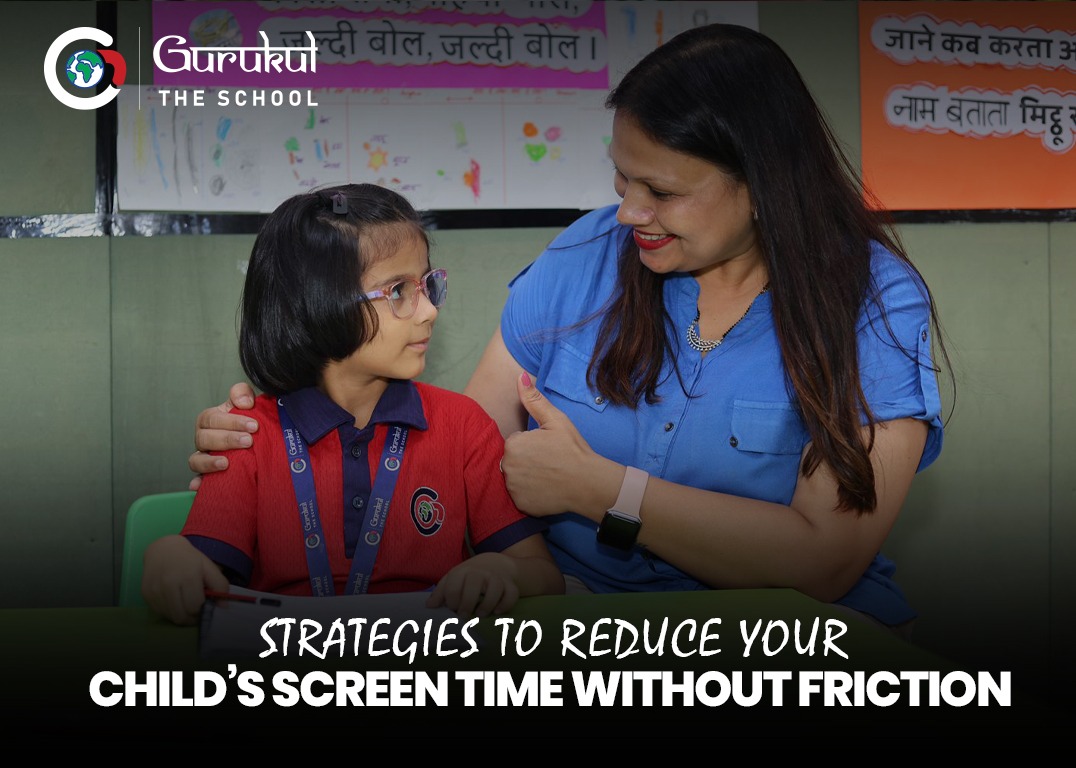Strategies to Reduce Your Child’s Screen Time Without Friction
posted on Jun 26, 2025
Gurukul The School, a top rating school in Ghaziabad, we believe the real problem is that most parents use screen-limiting strategies that work against how their children’s brains naturally operate.

Learning, entertainment, social interactions — all have been digitised over the recent years. It’s one of the reasons why children these days are seen spending more time on devices than they should. While limited screen time has somewhat become a necessity in today’s tech-driven world, the problem is that children are unknowingly developing a screen addiction. This has become one of the key causes of worry for many parents.
If you’ve tried asking your kids to put down their devices after reasonable usage, you may have experienced negotiations, outright defiance, or teary-eyed appeals, all leading to no proper resolutions or some really bad guilt trips. At Gurukul The School, a top rating school in Ghaziabad, we believe the real problem is that most parents use screen-limiting strategies that work against how their children’s brains naturally operate.
What happens is that when we abruptly remove something engaging without offering equally appealing alternatives, we create a void that feels punishing to most children. This void attracts defiance or aggressive reactions. We at Gurukul The School understand that and have hence created this blog post featuring practical strategies to help lower your child’s screen time without friction. So, let’s explore all the strategies shared below.
-
Replace Before You Remove
One of the biggest mistakes that we have seen parents making quite repetitively is trying to end screen time for their kids without having something ready to fill that space. Since children need immediate engagement, an empty transition period can bring resistance.
Hence, we advise parents to quietly prepare a list of three specific activities they can choose from before announcing that screen time is over. It can be any simple activity, like charging a Bluetooth speaker for an upcoming party or placing plates at the dinner table.
The key is making these alternatives visible and accessible the moment screens go away. When kids have an activity waiting to be performed, the transition from screen time to the real world becomes resistance-free and smooth.
We often recommend this strategy to parents because it’s simple yet incredibly effective. You can notice a common phrase whenever you ask your kids to stop using any device — five more minutes. Unfortunately, these five extra minutes become twenty minutes and even more because time is abstract for children.
They cannot visualise how long five minutes actually last, which makes every time warning feel arbitrary and unfair. Hence, visual timers solve this problem really well by making time concrete, visible, and manageable. You can place a stopwatch or any other timer that lets your children view the countdown.
This simple strategy shifts control from you constantly nagging about time to them managing their own limits. The visual timer lets children see how much time remains, mentally preparing them for the transition. Once children notice the time running out, they’ll start planning their activities for a more willing transition.
-
Make Other Stuff Easier to Grab
Not many parents notice this, but children naturally choose the easiest available option, which is why screens often win over other activities. Whether you talk about smartphones or tablets, they’re always charged, provide instant entertainment, and are generally available within arm’s reach. On the other hand, other engaging activities may require setup, searching for supplies, moving to different rooms, etc.
This is where strategic environmental changes can shift the balance to your liking. For example, moving devices to less convenient locations like a higher shelf while simultaneously placing art supplies in a readily available basket can gravitate your children towards art supplies as they require the least work to access.
According to us at Gurukul The School, this strategy always works because it uses your kids’ natural laziness tendency rather than fighting against it.
-
Join Them Instead of Fighting Them
We consider it one of the most powerful strategies as it requires parents to make themselves more interesting than what’s on screen, naturally encouraging children to put down their devices without friction.
Whenever you notice your kids watching YouTube videos or playing games, join them in whatever they do. You can suggest doing something together after a few minutes of genuine engagement. For example, if you were watching a cooking video, suggest cooking a delicious snack together.
If you were playing building games, suggest constructing something with actual blocks or Legos. Children will willingly leave screens in such cases because they feel understood and the proposed alternative activity connects to what they enjoy.
Conclusion
Many parents struggle with reducing their children’s screen time, especially when they’ve developed a habit of spending most of their day online. Resistance, arguments, and aggressive reactions become part of the everyday routine, weakening parent-child relationships and no real improvement in lowering screen times. If you experience it frequently, we at Gurukul The School, a top rating school in Ghaziabad, would like to advise you to consider changing your approach to the problem.
We recommend you implement the strategies discussed in this blog post, as they’re all easy to implement and can work on children with varying temperaments and personalities. Since these tips don’t go against how their brain functions, you can expect reduced screen times with minimal to no friction, that too, within a very short frame of time.